1.2 Software Engineering
Software has become embedded into every aspect of daily lives.
The information technology requirement demanded by individuals, business, and
governments grows complex with each passing year.
Individuals, business, and governments increasingly rely on software for strategic and
tactical decision making as well as day-to-day operations and control.
As the perceived value of a specific application grows, the likelihood is that its user base and
longevity will also grow. (随着应用程序应用价值的提升,其用户基础和寿命也会增长)
What is SE?
(1) The application of systematic, disciplined, quantifiable approach to the development,
operation, and maintenance of software; I.e. the application of engineering to software.
(2) The study of approaches as in (1) above.
Software engineering is a layered technology.
The bedrock that supports Software engineering is a quality focus.
The foundation for SE is the Process layer. Process defines a framework that must be
established for effective delivery of SE technology.(过程定义了传递 SE 技术的框架)
SE methods provide the technical how to build software.
SE tools provide automated or semi-automated support for the process and methods.
2.2 Process Models
Waterfall model: also called classic life cycle
Communication: Project initiation, requirement gathering.
Planning: estimating, scheduling, tracking
Modeling: analysis, design
Construction: code test
Deployment: delivery, support, feedback
Waterfall model strength
Easy to understand, easy to use
Provide structure to inexperienced stuff
Milestones are well understand
Set requirements stability
Good for management control
Work well when quality is more important than cost and schedule
Waterfall deficiencies
All requirement must be known upfront
Inhibits flexibility
�
Can give a false impression of the progress
Didn’t reflect the problem
It’s a big bang when integration
Little opportunity for customers.
When to use waterfall
The requirements are well known.
The production definition is stable.
Technology is understood.
A new version of existing production
Porting an existing production to a new platform
Structured evolutionary prototype model steps
A preliminary project plan is developed 定义一个最初的工程计划
An partial high-level paper model is created 创建部分的高级模型
The model is source for a partial requirements specification 这个模型是需求规格说明的来
源
A prototype is built with basic and critical attribute 利用基本和关键的属性构建原型
The designer builds the database, user interface, and algorithmic function 设计者设计数据
库,用户接口,算法功能
The designer demonstrates the product to customer for evaluation of the problems and
feedbacks.设计师展示产品,来获取客户评价和反馈
Loop until the customer satisfied 继续上诉过程知道客户满意
Prototype model strengths
Customer can “see” the system requirement(用户能够看到系统需求)
Designer learn from customer(设计者可以从客户学习)
A more accurate end product(开发出更精确的产品)
Unexpected requirements are accommodated(会有意想不到的需求)
Allows for flexible design and development(允许灵活的设计和开发)
Steady, visible signs of progress produced(产生了稳定的,可视化的过程标识)
Interaction with the prototype simulate awareness of additional needed functionality(用原
型进行交流,激励了对额外的功能需求的意识)
Weakness
Tendency to abandon structured program development for “code-and-fix” development(具
有因修补开发而放弃结构化程序开发的倾向。)
Bad reputation for “quick and dirty” methods. 方法太过快捷/脏乱
Overall maintainability may be overlooked。总体的维护可能被忽略
Customer may want prototype delivered。客户会要求提交原型
Process may continue forever。开发可能永无止境
3.3 Agile Process
Agile principle
�
Highest priority is satisfy customer
Welcome requirement changing
Deliver working software frequently
Business people and developer work together
Build project around motivated individuals(围绕个人积极性构建项目)
Emphasize face-to-face communication
Working software is primary measure of progress(可运行的软件是进度的首要度量)
Agile processes promote sustainable development.(提倡可持续开发)
Continuous attention to technical excellence and good design enhances agility.(不断地关注
优秀的技术和好的设计会增强敏捷能力)
Simplicity is essential(尽量减少不必要的工作)
The best architectures, requirements, designs emerge from self-organizing team.(自组织的
团队)
The team tunes and adjusts its behavior accordingly.(团队有根据地自我协调行为)
Human factors
Competence
Common focus(共同的目标)
Collaboration(协作)
Decision making ability
Fuzzy problem solving
Mutual trust and respect(互相信任和尊重)
Self-organization(自我组织)
3.4 Extreme Programming
XP uses an object-oriented approach as its preferred development paradigm(范例)。
Framework activities
1
Planning
Begin with the creation of a set of stories
Each story is write by customer and placed on an index card
Customer assigns a value to the story
Agile team asses each story and assigns a cost
Stories are grouped for a delivery incremental
A commitment is made on deliver date.(承诺提交日期)
After the first project release delivered, its “project velocity” is used to help define the
subsequent delivery date.
2
3
Design
Follow the “keep it simple” principle
Encourage usage of CRC cards
For difficult design problem, suggest create a prototype(spike solutions)
Design occurs both before and after coding commences.
Coding
�
4
Recommends create a set of unit tests for each story, before coding commences
Encourage pair programing
Needs to integrate with other portions continuously, which provides “smoke testing”
Test
Use a framework to implement unit test, to make testing automated.
Integration and validation testing can occur in daily basis
Acceptance tests, also called customer test, are specified by the customer and executed
to assess customer visible functionality(用于评估用户可见的功能)
Acceptance tests are derive from user stories
4.1 Requirement Engineering
1
2
3
4
5
6
7
Inception
Basic understanding of the problem
Know who need the solution
The nature of the solution that is desired
The effectiveness of the preliminary communication and collaboration of the developer
and customer
Elicitation
Elicit requirements from all stakeholders
Elaboration
Create an analysis model that identifies data, function and behavioral requirements.
Negotiation
Agree on deliverable system that is realistic for developers and customers.
Specification:文档,模型,数学公式,用例,原型
Validation:确认是否有误,有遗漏缺失,是否一致
Requirement management
4.4 Developing Use cases
The first step in writing a use case is to define a set of “actors” that will be involved in the
story.
An actor and an end user are not necessary the same thing. An actor represents a class of
external entities.
Because requirements elicitation is an evolutionary activity, not all actors are identified
during the first iteration.
4.5Building Requirement Model
The intent of the analysis model is to provide a description of the required informational,
�
functional, and behavioral domains for a computer-based system.
There are many different ways to look at the requirements for a computer-based system.
Different modes of representation force you to consider requirements from different
viewpoints—an approach that has a higher probability of uncovering omissions,
inconsistencies, and ambiguity.
Elements of the Requirements Model
Scenario-based elements
The system is described from the user’s point of view using a scenario-based approach.
Scenario-based elements of the requirements model are often the first part of the model
that is developed.
Class-based elements
Each usage scenario implies a set of objects that are manipulated as an actor interacts with the
system. These objects are categorized into classes—a collection of things that have similar
attributes and common behaviors.
Behavioral elements
The behavior of a computer-based system can have a profound effect on the design that is
chosen and the implementation approach that is applied.
Flow-oriented elements
Information is transformed as it flows through the computer-based system.
Analysis Pattern
�
5.1 Requirement Analysis
Scenario-based models of requirements from the point of view of various system “actors”.
Data models that depict the information domain for the problem.
Class-oriented models that represent object-oriented classes (attributes and operations)
and the manner in which classes collaborate to achieve system requirements.
Flow-oriented models that represent the functional elements of the system and how they
transform data as it moves through the system.
Behavioral models that depict how the software behaves as a consequence of external
“events”.
The requirements model is a bridge between the system description and the design model.
The analysis model(即需求模型) and requirements specification provide a means for assessing
quality once the software is built.
The requirements model Must Achieve
(1) to describe what the customer requires
(2) to establish a basis for the creation of a software design
(3) to define a set of requirements that can be validated once the software is built.
5.2 Scenario based Modeling
6.2 Flow Oriented Modeling
DFD 采取了系统的输入-处理-输出观点。
数据对象用箭头表示,转换用圆圈表示(或者说是 Bubble)
第 0 层的 DFD 图把系统当作一个整体。
认为 DFD 已经过时不适用是一种错误的观念。在分析时,它很有用来描述需求的潜力。
导出数据流图(DFD)的指导原则:
1. 第 0 层的数据流图应该吧软件或系统描述为一个泡泡。
2. 应该仔细标注壮阳药的输入和输出。
3. 通过把选定的处理、数据对象和数据存储分离为下一层表示而开始精化。
4. 应使用有意义的名称标记所有的箭头和泡泡。
5. 当从一个层转到另一个层时要保持信息流的连续性。
6. 一次精化一个泡泡。
A large class of applications are “driven” by events rather than data, produce control
information rather than reports or displays( 而 不 是 报 告 或 者 显 示 信 息 ), and process
information with heavy concern for time and performance. (关注时间和性能)。这类应用程序
需要使用的 control flow modeling.
控制规格说明(Control specification, CSPEC)使用两种不同的方式表现系统的行为。The CSPEC
�
contains a state diagram(状态图) that is a sequential specification of behavior(行为的序列
说 明 ) . It can also contain a program activation table ( 程 序 激 活 表 ) —a combinatorial
specification of behavior(行为的组合说明)。
7.3 Design concepts
9.2 Designing class based component
Basic Design Principles
使用如下原则定义软件组件
The Open-Closed Principle(OPC):对扩展开放,而对修改关闭。无需组件自身修改过就可以进
行扩展的方式来说明组件。可以通过接口实现。
The Liskov Substitution Principle(LSP)基类的组件可以使用子类的功能。
Dependency Inversion Principle(DIP)依赖于抽象,而非具体实现类。
The Interface Segregation Principle(ISP)如果不同的客户使用相同的方法,应该为不同的客户
定制专用的接口。接口分离原则。
使用如下原则打包软件组件
The Release Reuse Equivalency Principle, 复用的粒度(granule)就是发布的粒度。使得开发者
在发布新版是能够重用旧版组件用非重写。
The Common Closure Principle, Classes that will change together belongs together.
The Common Reuse Principle, Classes that aren’t reused together should not be grouped
together.
Cohesion
Functional Cohesion(功能内聚) :有操作来体现,由一个模块来完成某一组特定操作并返回结
果。
Layer Cohesion(分层内聚):由包,组件和类来体现。高层能够访问底层服务,而底层不能访
问高层服务。
Communicational Cohesion(通信内聚):访问相同数据的所有操作被定义在一个类中。
Coupling
Content Coupling: Occurs when one component “surreptitiously( 暗 中 ) modifies data that is
internal to another component”。
Common Coupling: Occurs when a number of components all make use of a global variable.
�
Control Coupling
Stamp Coupling:参数调用
Data Coupling:传递长串数据
Routine( 例 程 调 用) Call Coupling: Certain types of coupling occur routinely in object-oriented
programming.
Type Use Coupling: A 中使用 B 作为属性
Inclusion or Import Coupling:组件 A 中 import 了组件 B 的包或者内容
External Coupling:组件之间进行通信
10.4 Interface design steps
The Golden Rules of User Interface Design
Place the User in Control:用户操纵控制
Reduce the User's Memory Load:减少用户记忆规则
Make the Interface Consistent:保持界面一致
General steps for user interface design
1) Using information developed during user interface analysis, define user interface objects
and actions (operations)
2) Define events (user actions) that will cause the state of the user interface to change; model
this behavior
3) Depict each interface state as it will actually look to the end user(描述每个界面状态)
4)
the interface(简要说明用户如何从界面提供的界面信息来解释系统状态)
Indicate how the user interprets the state of the system from information provided through
Interface objects and actions
Interface objects and actions are obtained from a grammatical parse(词汇分析) of the use
cases and the software problem statement(从用例文本中获得的动词和名词)
Interface objects are categorized into types: source, target, and application(源、目标和应
用对象)
After identifying objects and their actions, an interface designer performs screen layout(进
行界面布局)
Design Issues to Consider
System response time (both length and variability)
User help facilities
Error handling (more on next slide)
Menu and command labeling (more on upcoming slide)
Many software engineers do not address these issues until late in the design or construction
process, it result to unnecessary iteration, project delays and customer frustration.
�
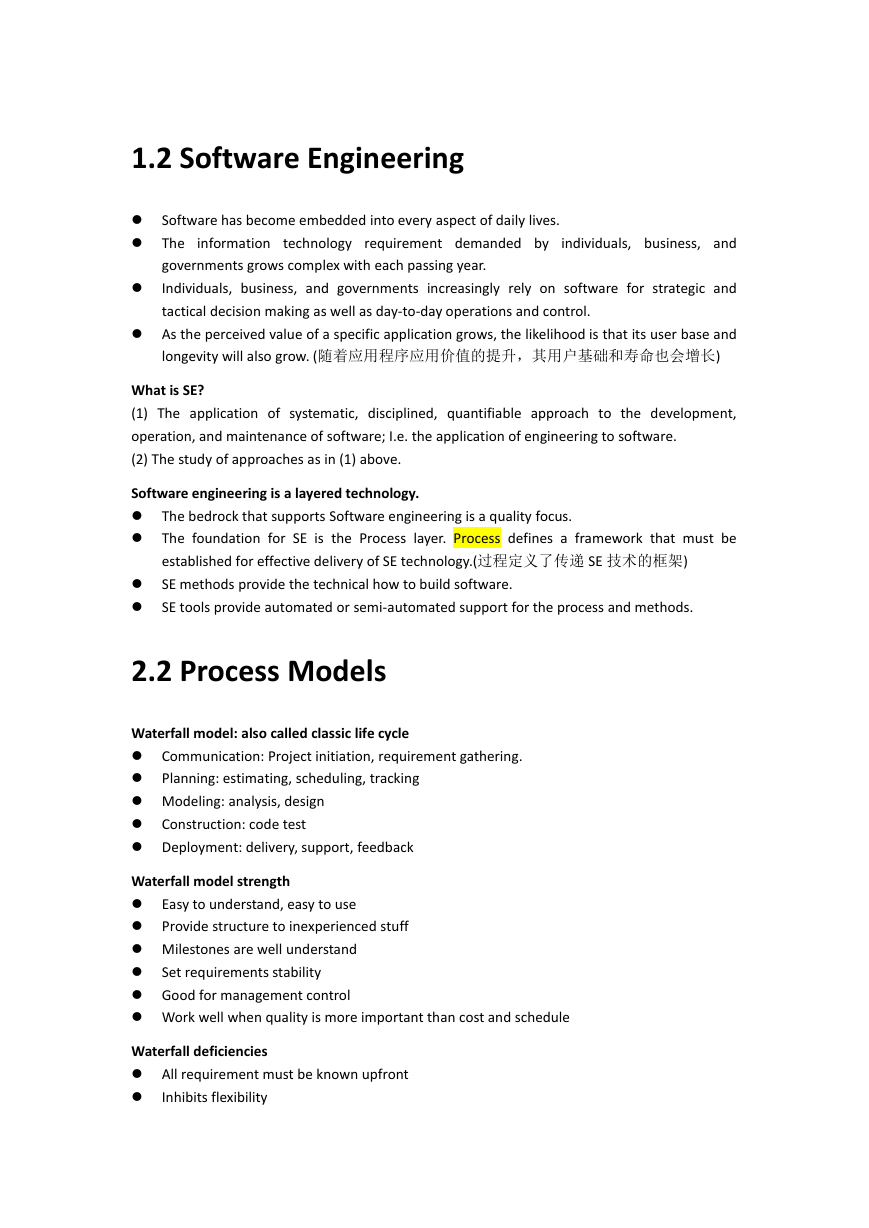
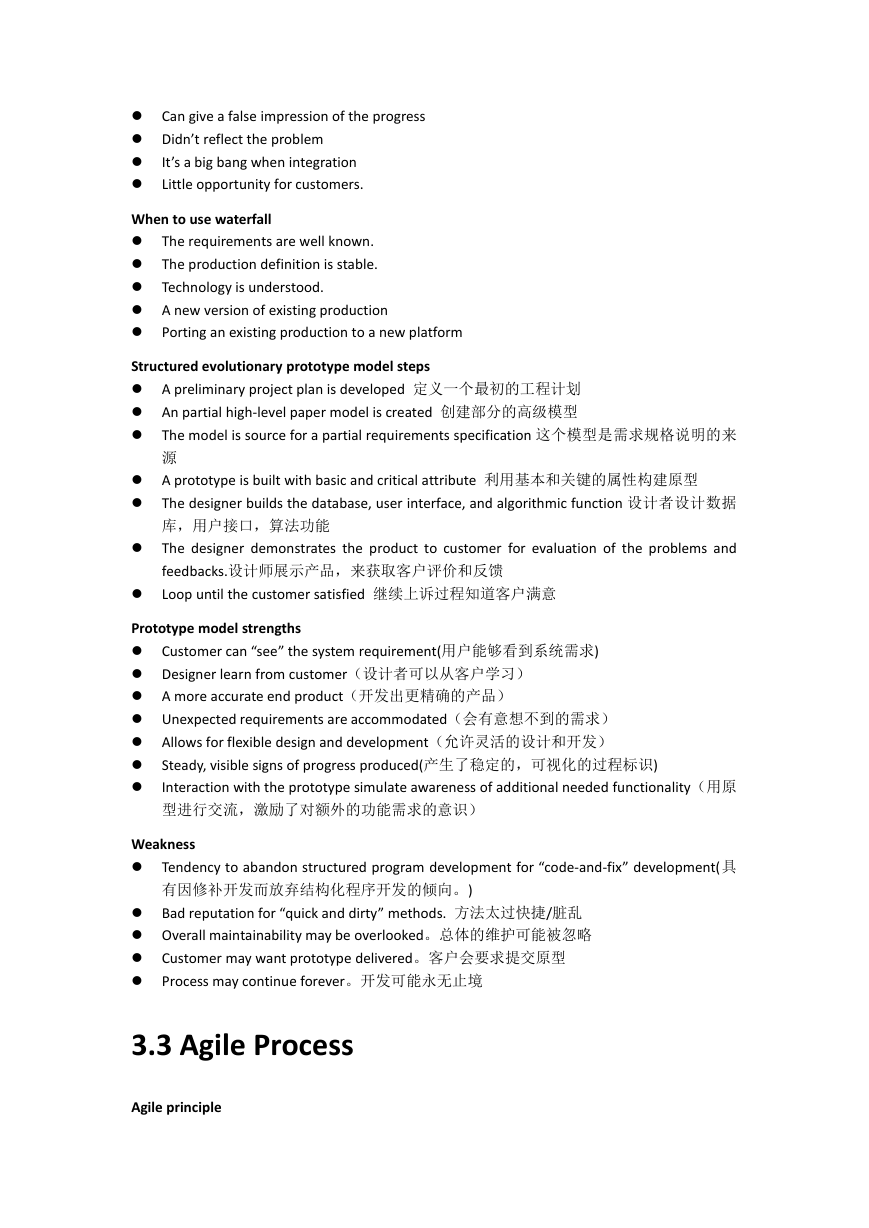
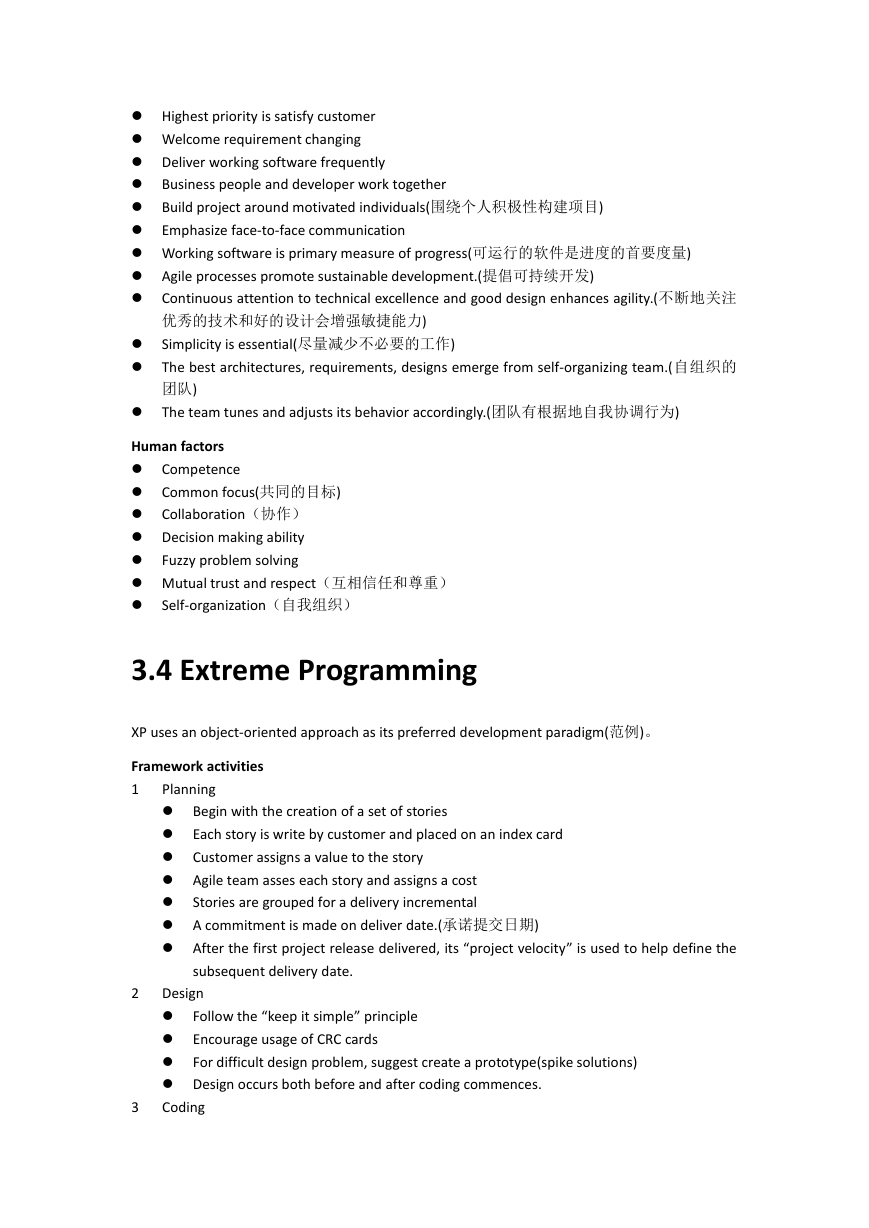
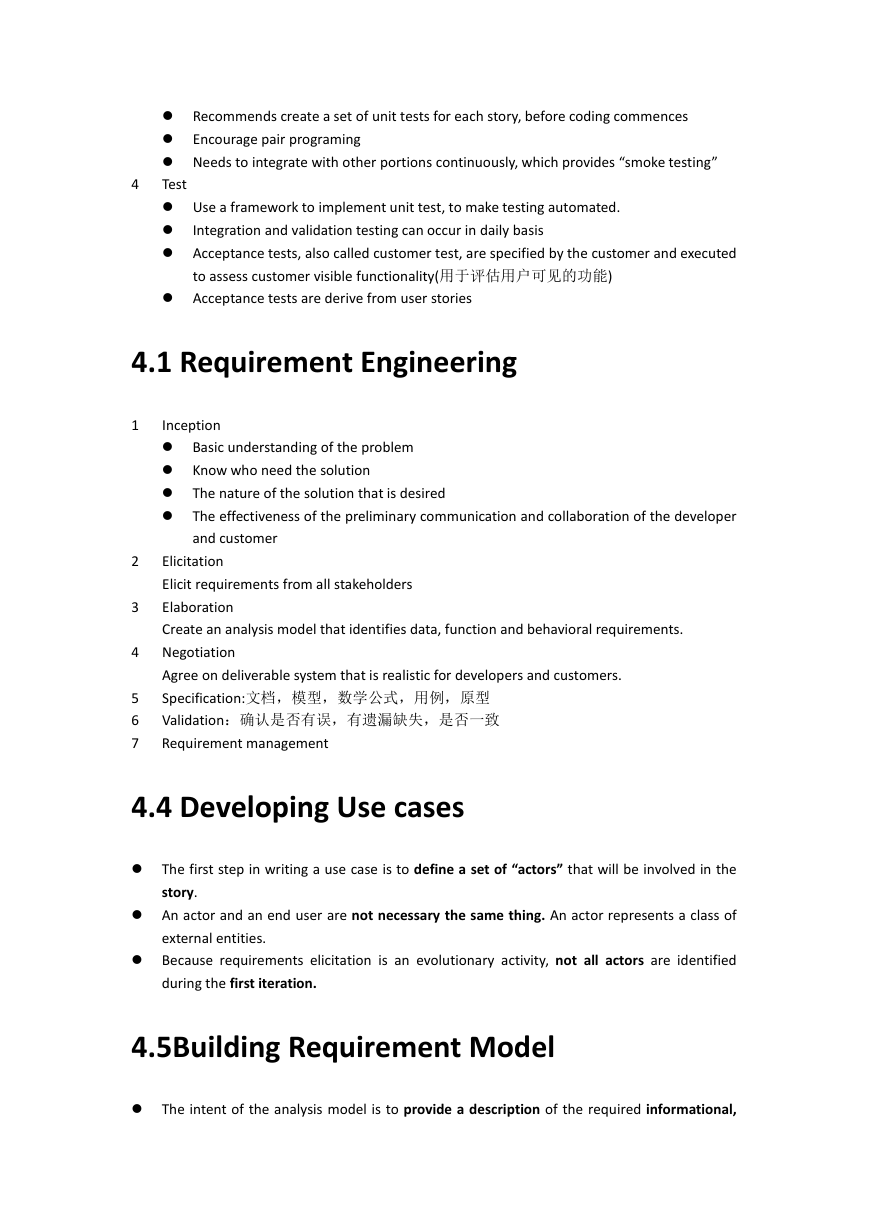

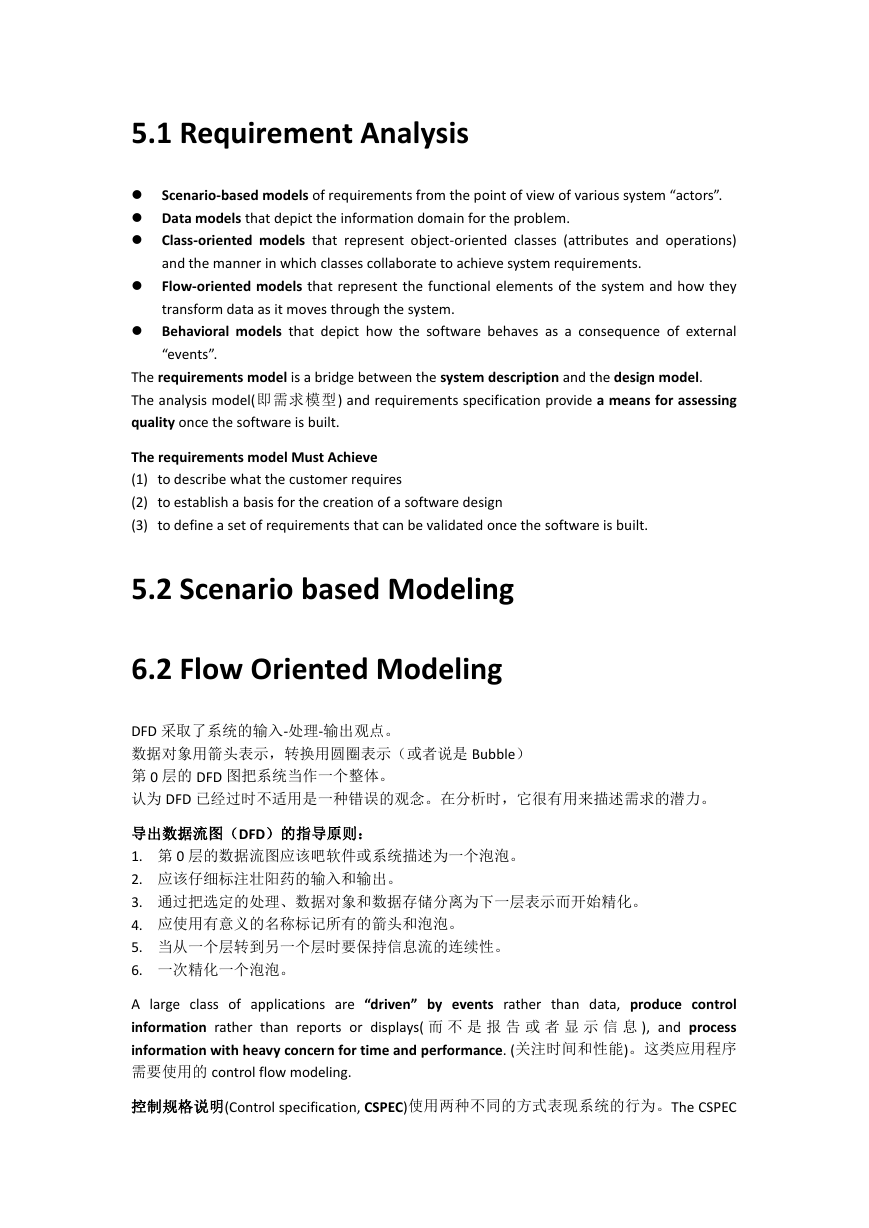

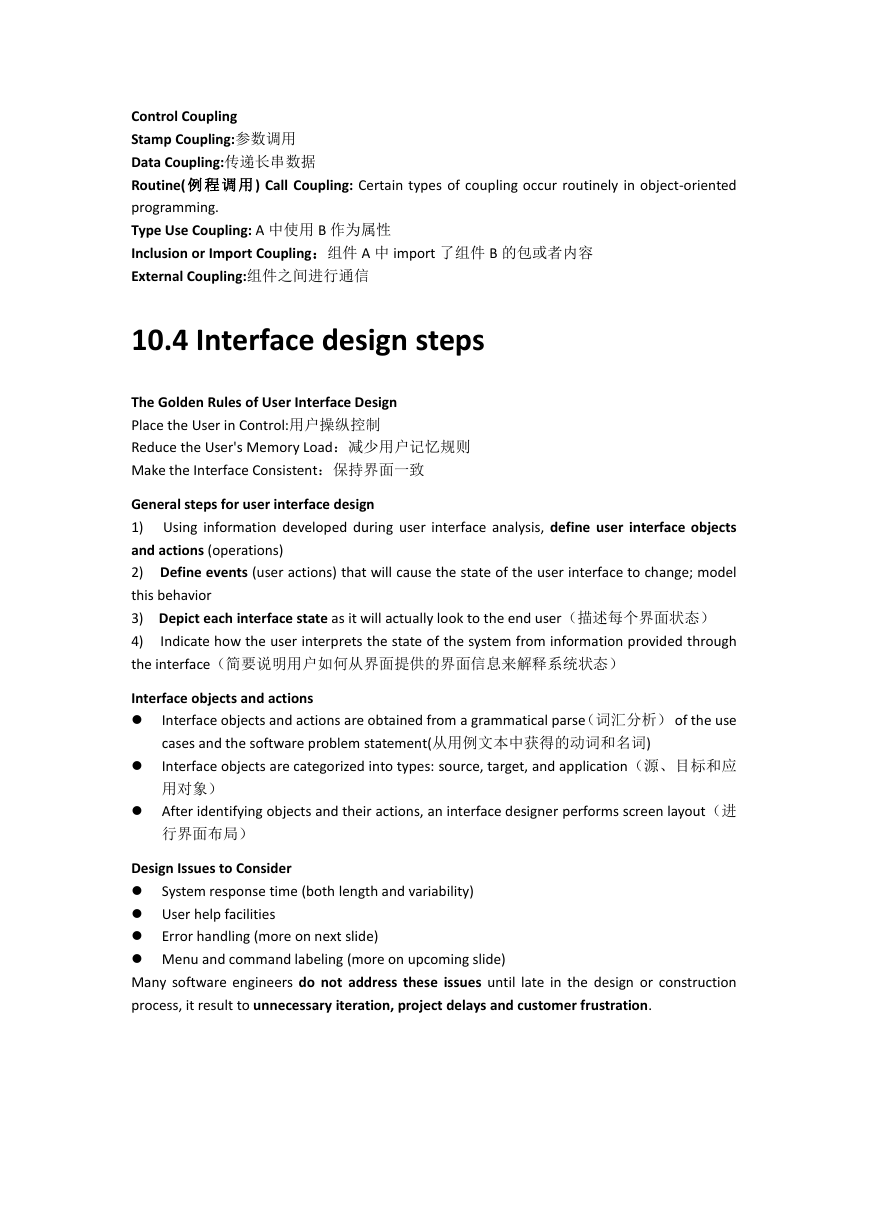








 2023年江西萍乡中考道德与法治真题及答案.doc
2023年江西萍乡中考道德与法治真题及答案.doc 2012年重庆南川中考生物真题及答案.doc
2012年重庆南川中考生物真题及答案.doc 2013年江西师范大学地理学综合及文艺理论基础考研真题.doc
2013年江西师范大学地理学综合及文艺理论基础考研真题.doc 2020年四川甘孜小升初语文真题及答案I卷.doc
2020年四川甘孜小升初语文真题及答案I卷.doc 2020年注册岩土工程师专业基础考试真题及答案.doc
2020年注册岩土工程师专业基础考试真题及答案.doc 2023-2024学年福建省厦门市九年级上学期数学月考试题及答案.doc
2023-2024学年福建省厦门市九年级上学期数学月考试题及答案.doc 2021-2022学年辽宁省沈阳市大东区九年级上学期语文期末试题及答案.doc
2021-2022学年辽宁省沈阳市大东区九年级上学期语文期末试题及答案.doc 2022-2023学年北京东城区初三第一学期物理期末试卷及答案.doc
2022-2023学年北京东城区初三第一学期物理期末试卷及答案.doc 2018上半年江西教师资格初中地理学科知识与教学能力真题及答案.doc
2018上半年江西教师资格初中地理学科知识与教学能力真题及答案.doc 2012年河北国家公务员申论考试真题及答案-省级.doc
2012年河北国家公务员申论考试真题及答案-省级.doc 2020-2021学年江苏省扬州市江都区邵樊片九年级上学期数学第一次质量检测试题及答案.doc
2020-2021学年江苏省扬州市江都区邵樊片九年级上学期数学第一次质量检测试题及答案.doc 2022下半年黑龙江教师资格证中学综合素质真题及答案.doc
2022下半年黑龙江教师资格证中学综合素质真题及答案.doc